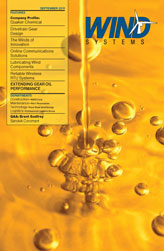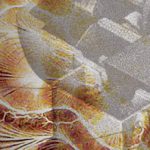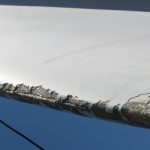More than a decade ago Castrol Optigear® Synthetic A 320 (OGSA 320) was developed to meet specific criteria developed by the National Renewable Energy Lab (NREL) for use in wind turbine gearboxes. OGSA 320 was submitted along with products from other major lubricant suppliers. The gear oils were tested against specific criterion that included operating temperature range, protection against micropitting wear, and the ability to last up to 20 years in the gearbox.
Castrol Optigear Synthetic A 320 outperformed all other oils in the micropitting resistance tests due to its unique Microflux-Trans® (MFT) anti-wear and anti-scuffing additive system. Under extreme loads the organo-metallic additives in the MFT system enhance the gear surfaces by plastic deformation. This smoothing of the surfaces increases the load bearing surface area, thereby reducing wear and lowering friction.
Visual evidence of MFT’s surface smoothing effect can be seen in Figure 1 and Figure 2. Figure 1 shows a highly magnified wear scar surface from an SRV wear test with a conventional gear oil. Figure 2 show the SRV test surface using MFT surface-active technology.
Castrol Optigear Synthetic A 320 quickly became the industry standard for wind turbine gear oils and gained approval from many of the wind turbine OEMs for first fill, in large part due to its superior micropitting protection. OGSA 320 has been operating successfully in over 17,000 turbines worldwide.
Performance Issues Arise
With the original goal of a 20-year life set forth by NREL—note that the current gearbox lifespan is expected to be 10 years—the anti-wear and anti-scuffing MFT additives were formulated in robust proportions. It is known that the MFT additive package is somewhat hygroscopic and will take up certain amounts of water. This was not an issue in the field until wind farms began to expand from arid climates to more-humid locations such as the Midwest and Upper Midwest regions of the United States.
In a very small percentage of turbines filled with OGSA 320, water content became an issue. Where water determination by Karl Fischer results showed greater than 500 ppm water, some turbines experienced precipitation of the additives. The resulting additive fallout residue caused premature filter loading, and in some cases false low oil level alarms due to interference with the low oil level sensor. Even with this additive fallout, however, levels in the oil remained above the minimum specifications and wear protection of the gears and bearings were never compromised. Additionally, oil life did not appear to be negatively affected.
In an attempt to mitigate and respond to these issues caused by high water content, Castrol Detergen® System Cleaner (DSC) was added to the gear oil in small percentages in several turbines. DSC has been in the Castrol product line for more than 20 years and is an oil-based cleaner containing detergents and dispersants. It dissolves sludge residues and is routinely used for cleaning industrial gearboxes and hydraulic systems prior to oil changes. After it was added to the problematic wind turbine gearboxes, improvements were quickly noted: additive residues were eliminated from the filters, and false low oil level alarms stopped.
Laboratory Testing Verification of Water Effect
The additive precipitation described above, and reduced additive levels also presented in a small percentage of field cases. In early 2010 Castrol performed extensive laboratory testing to validate the effects of water on OGSA 320, and to verify positive field experience that DSC can reduce the negative effect water engress has on the additive system.
Water Effect on Optigear Synthetic A 320 Additive System
Four samples were prepared: 1) control sample new OGSA 320; 2) OGSA 320 with 500 ppm water; 3) OGSA 320 with 750 ppm water; and 4) OGSA 320 with 1,000 ppm water. Visual inspection confirmed that there is no additive fallout in the OGSA 320 control sample without water. However, in the water-contaminated samples the field experience was confirmed and certain additives were seen to precipitate out and cause a residue. Figure 3 shows the sample with 750 ppm water, and a light brown sludge can be seen at the bottom of the cylinder.
The Optigear Synthetic A 320 additive system consists of magnesium (Mg), molybdenum (Mo), zinc (Zn), and phosporus (P) typically in levels ranging from 1,200-1,800 ppm for new oil, with minimum limits on used oil from 400-3,000 ppm. Spectrographic analysis of the top and bottom layers of the oil samples found approximately 2X the levels of Mg and Mo on the bottom as compared to the top layers of the sample with 750 ppm water. This confirmed that the residue was indeed additive fallout. Of the three, the sample with 750 ppm had the most dramatic difference between the top and bottom layers. Based on this testing, the following conclusions can be made regarding the water effect on the OGSA 320 additive system:
• OGSA 320 with no water added is stable with no additive precipitation;
• At water levels over 500 ppm, additive precipitation and fallout can occur;
• With 750 ppm water added, OGSA 320 can form additive fallout residue, particularly of the Mg and Mo components of the additive system;
• Water at these levels does not have a significant impact on P and Zn.
Castrol Detergen System Cleaner Effect on Additive Precipitation
Laboratory testing and field experience clearly indicate that certain additives, primarily Mg and Mo, can precipitate out of solution and form residue when OGSA 320 is exposed water contamination in excess of 500 ppm. To investigate the effect DSC can have on mitigating this issue, 2- and 5-percent dosages were added to the samples with 500 and 750 ppm of water and fallout present. After the DSC was added, the samples were agitated and allowed to cure for 48 hours. The DSC immediately cleaned up the residue fallout in both samples. Figure 4 shows the sample with 750 ppm water and 5 percent DSC with no fallout present.
Spectrographic analysis of the top and bottom layers of the oil samples confirmed that the additives went back into solution. The amounts of Mg and Mo in both layers were approximately equal and back to normal. This supported the visual conclusion that the fallout residue became soluble back into the oil. Based on testing, the following conclusions can be made regarding the effect of DSC on additive precipitation:
• DSC caused the precipitated additive components to go back into solution;
• OGSA 320 that had additive fall out residue in the presence of 750 ppm water appeared clear with no distinct layers after the addition of 5 percent DSC;
• At 5 percent DSC added, the amounts of Mg and Mo in both the top and bottom of the oil sample layers became approximately equal;
• DSC does not have a significant impact on P and Zn.
Castrol Detergen System Cleaner Effect on Wear Protection, Foaming, and Filter Life
After it was determined by lab testing that the addition of DSC had the desired positive impact, further testing was performed to see what effect the DSC would have on other key performance properties of OGSA 320. For all of these tests, three samples were used: 1) control sample new OGSX 320; 2) OGSX 320 with 750 ppm water and 2 percent DSC; and 3) OGSX 320 with 750 ppm water and 5 percent DSC.
SRV wear tests were performed on the three samples. The addition of 2 or 5 percent of DSC did not have any significant effect on either wear scar diameters or the coefficient of friction of OGSA 320 as compared to the control sample. In fact, a scar diameter of 0.44 mm was reported for the DSC and water containing samples, which is lower than the 0.50 mm scar diameter for new OGSA 320.
ASTM D-892 foam test was performed on the three samples. All of the samples (without DSC added) were placed in a 60 C oven for two weeks and tested. As expected, the control sample exhibited excellent anti-foaming properties in all sequences of the test. The presence of 750 ppm of water greatly increased foaming, especially at the elevated temperature of sequence II. The two samples with 750 ppm water were then dosed with 2 and 5 percent DSC, and all samples were placed back in a 60â° C oven for two weeks. The sample with 2 percent DSC with 750 ppm water reduced foaming by one half, versus the sample without DSC. At 5 percent DSC level foaming was practically eliminated in both the sample with 750 ppm water and the control sample.
Filter life is impacted by many variables that are not related to the oil, such as external contamination. However, filterability of the oil as measured in the amount of oil-generated particles remaining on the filter media also impacts filter life. To test this, 25 mLs of each sample was filtered through a 2.7 micron filter. The filter papers were carefully weighed before and after filtering and after being dried, and the results reported in percentage of mass change. Mass change of the filter is directly related to the amount of additive precipitation. With 750 ppm water in OGSA 320 and without DSC, the percentage of mass increased by 2.6 times due to the additive fallout. With 2 percent DSC added to the sample with 750 ppm water, the percentage of mass change is about equal to a new OGSA 320 sample without water or DSC. With 5 percent DSC added the percentage of mass change was reduced more than 10 times versus the sample with 750 ppm water and no DSC, and five times lower than the new OGSA 320 sample without water or DSC. Laboratory testing conclusions showed that:
• Certain additives, especially Mg and Mo, can precipitate and fall out of solution from OGSA 320 in the presence of 500 to 1,000 ppm water;
• The addition of low concentrations of DSC has no adverse effect on SRV friction or wear properties;
• With DSC added, OGSA 320 easily passed all foam tests and outperformed new oil (without water or DSC);
• Filterability is significantly improved with DSC even better than clean oil with no DSC;
• Any negative effects due to water contamination are completely mitigated by a low dosage treatment of Castrol DSC.
Field Experience with DSC
Subsequent to the laboratory testing, DSC has been added to more than 140 turbines filled with OGSA 320 and operated for three to six months. Since oil sample intervals are generally six months, we have only been able to review about 40 recent samples to compare the results to samples prior to the addition of DSC. The results have been good. Molybdenum levels are all well above the minimum requirements, and they have stabilized nicely. Cleanliness levels are good, and there have been no reports of any residue in the filters and filter housings that have been inspected. Neither have any issues concerning shortened filter life, or false oil level alarms caused by residue, been reported. A gear inspection of one turbine which had been in operation for three years using OGSA 320, and had 5 percent DSC added 90 days prior, showed clean gear tooth surfaces with no signs of pitting or wear (Figure 5).
Even in high humidity areas, a reduction in water content has been documented in many cases. In one controlled study of 10 GE 1.5MW wind turbines located in the upper Midwest, a 28 percent average reduction in water was reported after 60 days of adding DSC.
Conclusion
The addition of 5 percent Detergen System Cleaner to water-exposed Optigear Synthetic A 320 provides a safe, long-term solution to all known issues involving the precipitation of gear oil additives and resulting sludge formation. This solution does not impair the performance of the oil and will potentially extend the life of Optigear Synthetic A 320 fluid and system filters, while maintaining optimum wear protection. Currently the effect of the DSC as a long-term solution has only been tested with OGSA 320.
Where issues concerning water contamination of OGSA 320 are present, the addition of a small amount of DSC will enhance the performance of the oil and potentially extend its useful life. Wind farm owners can realize significant cost savings by extending the life of the oil by one or more years, and avoiding costly oil changeouts, while at the same time being confident that their wind turbine gearbox components are being protected from wear.
Next Generation Gear Oil
Being cognizant of the issues with OGSA 320, Castrol has developed the next generation in wind turbine gear oil: the Castrol Optigear Synthetic X 320. It has higher resistance to micropitting than its leading competitors, can provide greater protection to gearbox components, and extend the life of the gearbox. This product is more tolerant of water and performs exceptionally well in the most adverse conditions in any part of the country, with better filterability. Optigear Synthetic X 320 has several OEM first fill approvals for wind turbine gearboxes and is a great choice for a second fill gear oil to maximize the life of the gearbox and reduce total cost of ownership. Optigear Synthetic X 320 can last up to seven years before an oil change, resulting in a potential savings of up to $250,000 versus a typical competitor’s oil, which could need an oil change in this time.







































